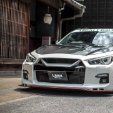Getting A Rwc On A Modified Car.
Announcements
-
Similar Content
-
Latest Posts
-
I have no hard data to report, but I have to say, having driven it to work and back all week, mostly on wet roads (and therefore mostly not able to contemplate anything too outrageous anywhere)..... it is real good. I turned the boost controller on, with duty cycle set to 10% (which may not be enough to actually increase the boost), and the start boost set to 15 psi. That should keep the gate unpressurised until at least 15 psi. And rolling at 80 in 5th, which is <2k rpm, going to WOT sees the MAP go +ve even before it crosses 2k and it has >5 psi by the time it hits 90 km/h. That's still <<2.5k rpm, so I think it's actually doing really well. Because of all the not-quite-ideal things that have been in place since the turbo first went on, it felt laggy. It's actually not. The response appears to be as good as you could hope for with a highflow.
-
By Dose Pipe Sutututu · Posted
Or just put in a 1JZ, and sell me the NEO head 😎 -
Oh, it's been done. You just run a wire out there and back. But they have been known to do coolant temp sensors, MAP sensors, etc. They're not silly (at Regency Park) and know what's what with all the different cars.
-
Please ignore I found the right way of installing it thanks
-
There are advantages, and disadvantages to remapping the factory. The factory runs billions of different maps, to account for sooooo many variables, especially when you bring in things like constantly variable cams etc. By remapping all those maps appropriately, you can get the car to drive so damn nicely, and very much so like it does from the factory. This means it can utilise a LOT of weird things in the maps, to alter how it drives in situations like cruise on a freeway, and how that will get your fuel economy right down. I haven't seen an aftermarket ECU that truly has THAT MANY adjustable parameters. EG, the VAG ECUs are somewhere around 2,000 different tables for it to work out what to do at any one point in time. So for a vehicle being daily driven etc, I see this as a great advantage, but it does mean spending a bit more time, and with a tuner who really knows that ECU. On the flip side, an aftermarket ECU, in something like a weekender, or a proper race car, torque based tuning IMO doesn't make that much sense. In those scenarios you're not out there hunting down stuff like "the best way to minimise fuel usage at minor power so that we can go from 8L/100km to 7.3L/100km. You're more worried about it being ready to make as much freaking power as possible when you step back on the loud pedal as you come out of turn 2, not waiting the extra 100ms for all the cams to adjust etc. So in this scenario, realistically you tune the motor to make power, based on the load. People will then play with things like throttle response, and drive by wire mapping to get it more "driveable". Funnily enough, I was watching something Finnegans Garage, and he has a huge blown Hemi in a 9 second 1955 Chev that is road registered. To make it more driveable on the road recently, they started testing blocking up the intake with kids footballs, to effectively reduce air flow when they're on the road, and make the throttle less touchy and more driveable. Plus some other weird shit the yankee aftermarket ECUs do. Made me think of Kinks R34...
-







Recommended Posts
Create an account or sign in to comment
You need to be a member in order to leave a comment
Create an account
Sign up for a new account in our community. It's easy!
Register a new accountSign in
Already have an account? Sign in here.
Sign In Now